For this church:    |
| |||||||||||||||||||||||||||||||||||||||||||||||||||||||||||||||||||||||||||||||||||||||||||||||||||||||||||||||||||||||||||||||||||||||||||||||||||||||||||||||||||||||||||||||||||||||||||||||||||||||||||||||||||||||||||||||||||||||||||||||||||||||||||||||||||||||||||||||||||||||||||||||||||||||||||||||||||||||||||||||||||||||||||||||||||
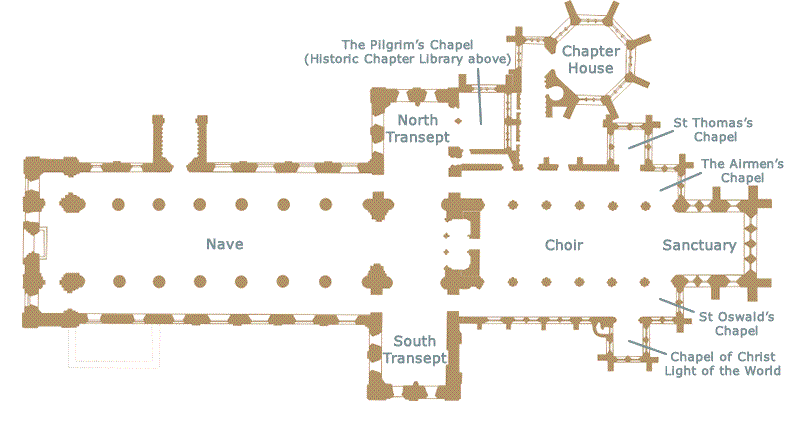 |
One of the striking features of the minster for visitors is the fact that, notwithstanding the variety of periods of building, and therefore of architectural styles, there remains a coherence and a simplicity within the building. It is very 'uncluttered' and this allows the various artefacts, monuments, fixtures, fittings and works of art to be seen and enjoyed to maximum effect.
Nave
North door
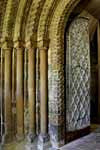 North door (left) North door (left) |
 North door (right) North door (right) |
This door is early to mid-14th century and the tracery was carved out of the solid wood. The motif is reticulated ogee, with quatrefoils inserted in each reticule. The cross-sections of the continuous raised muntins conform to rolls with three fillets. Since these were of maximum popularity between c1270 and c1330, a date close to 1300 is suggested for the installation of this door.
The inner porch was designed by Ronald Sims, Architect to the Cathedral and was built by Houghton’s of York in 1978. The Friends of Southwell Cathedral made a contribution to the cost.
Parvise room
The parvise room (sometimes merely 'the parvise') is situated above the north porch and is accessed from the north side triforium, which is not open to the public. There are steps down into the room from the triforium floor and the interior of the room is shown here. The photograph from c.1900 is of the north-west corner of the room and shows the fireplace and one of the three windows.
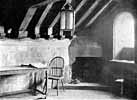 Parvise room interior Parvise room interior (c.1900) |
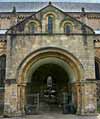 North porch and parvise North porch and parvise |
The photograph (left) of the exterior of the porch and the parvise, shows two smaller flanking windows and a larger central window, together with two pinnacles. The western one has holes in it and was in effect a chimney to take away the smoke from the fire shown in the interior view.
In medieval times the parvise was probably occupied by the sacristan, who was required to sleep in the church, act as a night-watchman, ring the bells at the appointed hours and be the caretaker of the collegiate church.
West door
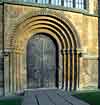 The West Door is made of oak and is, according to Pevsner, 12th century, with medieval ironwork. Dimock, in his book of 1898, says 'the oaken doors are of the same date as those of the north porch' and this seems much more likely.
The West Door is made of oak and is, according to Pevsner, 12th century, with medieval ironwork. Dimock, in his book of 1898, says 'the oaken doors are of the same date as those of the north porch' and this seems much more likely.
Clergy boards
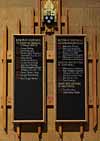 Attached to the first drum pillar east of the north-west tower are two wooden panels, mounted side by side. The westerly one lists the bishops since the foundation of the diocese and the easterly one lists the provosts (latterly deans) of the cathedral. Mounted centrally above the boards one may see the arms of the diocese.
Attached to the first drum pillar east of the north-west tower are two wooden panels, mounted side by side. The westerly one lists the bishops since the foundation of the diocese and the easterly one lists the provosts (latterly deans) of the cathedral. Mounted centrally above the boards one may see the arms of the diocese.
The clergy boards were designed by Ronald Sims in 1986 and made by Houghton’s of York. The cost was partially funded by the Friends of Southwell Cathedral. The Christian names of JJ Trebeck were inscribed wrongly on the right-hand board when it was made. He was baptized James John Trebeck, as shown correctly on his memorial tablet on the east wall of the North Transept. The 'Rectors of Southwell' Board was later corrected.
The names currently (2020) listed are:
|
|||||||||||||||||||||||||||||||||||||||||||||||||||||||||||||||
Cope chest
 This semicircular oak chest was given in memory of Edith Mary Caudwell in 1961. The inscription reads:
This semicircular oak chest was given in memory of Edith Mary Caudwell in 1961. The inscription reads:
GIVEN IN 1961 IN MEMORY OF EDITH MARY CAUDWELL 1878 - 1958 |
It was designed by W D Caroe and made by A Robinson of Kingston-upon-Thames. It normally houses 14 copes.
Font
 Font Font |
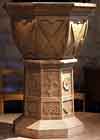 Detail Detail |
It is not known what happened to the medieval font but it was probably removed during the Civil Wars. The present font is dated 1661, one year after the Restoration of the Monarchy. This font was one of a commission of ten fonts made by William Baulme: the other nine are in other Nottinghamshire churches. According to the minster accounts for 1661/2 the font cost £3 2s 6d and a further 1s was paid for 'Workmen to drink for setting up ye font.'
The Victorian counterbalanced cover with the dove of peace above may be raised and lowered by hand.
Nave pulpit
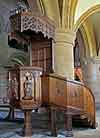 Nave pulpit Nave pulpit |
 Stairs Stairs |
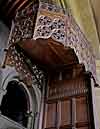 Canopy Canopy |
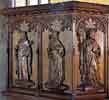 Detail Detail |
This is a late Victorian work made by Rattee and Kett of Cambridge from a design by G F Bodley. The carved figures are of King Edwin of Northumbria; his wife Queen Ethelburga (formerly Princess Ethelburga of Kent); St. Augustine (the first Archbishop of Canterbury); the Blessed Virgin Mary with Jesus; and St Paulinus (the first Bishop of York and later de facto Archbishop of York, though never installed) with the White Rose of York on his robes.
The carved figures reflect the minster’s links with the early church and in particular with York. Paulinus, who came from Rome with Augustine, converted Ethelburga to the Christian Faith, baptized her and became her personal priest. When she journeyed north to marry Edwin, Paulinus accompanied her and began to baptize many people in the East Midlands and North. King Edwin resisted conversion but eventually Ethelburga made it a condition of marriage, so he was baptized by Paulinus in York – kneeling at a spot where Edwin later began the building of the first York Minster.
On the ledge inside the pulpit is the following inscription:
| To the Glory of God and in memory of the Revd John Gordon and Frances Octavia his wife. |
The pulpit was donated by a Miss Gordon (presumably a daughter) and was dedicated at Evensong on 11 September 1898 by Bishop Ridding.
Close examination of the column to the east of the Nave Pulpit reveals the faint outline of a figure on the stone: it is thought that there may have been a brass cut-out showing the Virgin Mary here.
Nave lectern
 The eagle lectern in the nave is a copy of the 'Newstead Lectern' in the choir. The original podium provided for this lectern featured some very fine wrought iron work and on the step the words 'Laus Deo' (Praise be to God) could be seen picked out in nails. At present however, that podium is not in use and readers use a small plain wooden two-step platform made by David Hall in the year 2000.
The eagle lectern in the nave is a copy of the 'Newstead Lectern' in the choir. The original podium provided for this lectern featured some very fine wrought iron work and on the step the words 'Laus Deo' (Praise be to God) could be seen picked out in nails. At present however, that podium is not in use and readers use a small plain wooden two-step platform made by David Hall in the year 2000.
Nave altar
The nave altar, made by Houghton’s of York, was a gift from the Friends of Southwell Cathedral in 1988.
Nave choir stalls
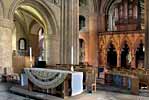 Nave altar and choir stalls Nave altar and choir stalls |
These stalls were a gift from the Friends of Southwell Cathedral. They were designed by Martin Stancliffe and made by Houghton’s of York in 1997. They incorporate tapestry hangings made by a partially-sighted designer Jacqueline James of York. These show red and blue alternately, but they can be reversed to show a neutral background in Lent and Advent.
The modern clergy seats and the stools are by Robert Thompson and Son of Kilburn and feature the trademark carved mouse.
Nave chairs
There are 1,000 nave chairs. They were manufactured in 1980 by Reynolds of Ludlow and were a gift from the Friends of Southwell Cathedral in anticipation of the centenary of the Diocese in 1984. The cost was over £28,000 and was at that time the largest single donation made by the Friends.
Notice boards
There are two wheeled notice boards, normally situated at the west end of the nave on the north side. The larger one was made by Thomas Long of Nottingham in 1959 and the smaller one was made by Robert Lee of Southwell in 1947.
Christus Rex
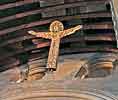 |
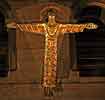 |
 |
This figure of the risen Christ was created in 1987 by Nottinghamshire sculptor Peter Ball. The body is made of elm and the arms are made of oak: it is covered in copper and gold leaf. Christ has his arms outstretched to welcome all who come to the minster. The Friends of Southwell Cathedral made a contribution to its cost.
In 2003 it was lowered to the floor of the nave to be cleaned and re-gilded by the artist. The cost of this work was covered by the Friends of Southwell Cathedral.
South transept
The south door
The south door is painted deal of the 18th century. The inner doors were dedicated on 4 November 1995 and carry an inscription in memory of Andrew Dakin:
Door to the east
| REMEMBER BEFORE GOD ANDREW DAKIN 1966 1993 |
Door to the west
| FOR FIVE YEARS A CHORISTER HERE 1974 1980 |
These doors were converted to automatic operation to provide wheelchair access in 2009.
Flight into Egypt bas relief
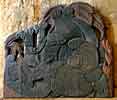 The bas relief fixed to the west wall of the south transept depicts ‘The Flight into Eqypt’ and is by the Newark artist Robert Kiddey (1900-1984). It dates to 1937 and was given to the minster by George Bennet in 1987.
The bas relief fixed to the west wall of the south transept depicts ‘The Flight into Eqypt’ and is by the Newark artist Robert Kiddey (1900-1984). It dates to 1937 and was given to the minster by George Bennet in 1987.
This large piece measures about 2 m x 2 m and is on six wood panels in Kiddey's favourite Burmese Teak, carved in low relief. It shows Mary and baby on a donkey with Joseph ahead of them on foot. Two companions on camels are riding alongside in the background.
Bread Pews
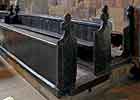 Bread Pews Bread Pews |
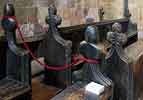 |
 Detail Detail |
Dating from the fifteenth Century, these pews are where the needy sat to receive bread and money. They are placed out of sight of people in the nave and are situated by the south door, the entrance by which clergy have always entered the minster. Underneath the most southerly of the pews is a fragment of flooring consisting of mosaic tiles, with a board offering visitors the following information:
The tiled area beneath The mosaic tiles |
The Saxon church mentioned is the Saxon minster which stood on the site prior to the building of the present Norman minster. Whilst the board is still displayed, current archaeological thinking considers that the mosaics may be from another Roman building. Display lighting for the tiles was provided by the Friends of Southwell Cathedral in 1985.
Pieta
This work, the smallest of the four Peter Ball pieces in the minster, can be found in the south transept. It depicts a sorrowing Mary cradling the figure of the dead Christ in her arms. It was given in memory of Mrs Pamela Irvine, the wife of Provost Murray Irvine.
South transept charity board
Set against the left-hand edge of the arch of the former southern apse, and partially curved to fit that arch, the charity board tells us:

MR CHARLES
|
||||||||||||||
Kelham Madonna
 This wooden sculpture of the Madonna and Child was created in 1952 by Alan Coleman. It was formerly in the Chapel of Kelham Hall, once home to The Society of the Sacred Mission, an Anglican Order which offered training for the priesthood to men who otherwise would not have been accepted. When the Society left Kelham Hall in 1974, the piece was presented to the Minster.
This wooden sculpture of the Madonna and Child was created in 1952 by Alan Coleman. It was formerly in the Chapel of Kelham Hall, once home to The Society of the Sacred Mission, an Anglican Order which offered training for the priesthood to men who otherwise would not have been accepted. When the Society left Kelham Hall in 1974, the piece was presented to the Minster.
The north transept
Millennium Pilgrim
This sculpture, carved by Rory Young, was commissioned by the Friends of Southwell Cathedral and installed in 2001. The 'blue patch' in the stone was only encountered by the artist during the carving process and does not have any symbolic significance.
The Pilgrim’s Chapel
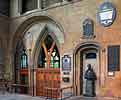 Entrance to chapel Entrance to chapel |
 Panoramic view of Panoramic view of the Pilgrim's Chapel looking north-west |
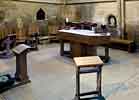 View looking north-east View looking north-east |
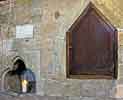 Piscina and aumbry Piscina and aumbryon the south wall |
This chapel is situated on the east side of the north transept, from whence it is entered by steps down from it. It has had a varied past, serving as the first Airmen’s Chapel, minster library, choir song-school and vestry. It is in the Early English Gothic style and was probably built at the same time as, or immediately after the completion of the choir: perhaps in c1250. It replaced the Norman apsidal chapel on the north side of the church.
Its interior, with two piscinas, two aumbries and two altar stones, reflect the fact that it was built as twin chapels, with two entrances accessed via broad steps. There is evidence that these two chapels were dedicated to St Nicholas and St Stephen. Viewed from the transept, the Early English pillar is not centrally placed within the former apsidal arch, but, having entered, one can see that the pillar divides the chapel into two equal sections with equal vaults.
In 1884 the twin chapels were abandoned and the whole area furnished as a single chapel, designated the Chapel of St Eadburgh. St Eadburgh, Abbess of Repton, the only Saxon woman to be canonized, died and was buried at Repton. The persistent fighting and skirmishing which took place in Mercia led to her body being moved to Southwell, where a shrine was established. It is not known where this was located, but it must be assumed that after the building of the Saxon Minster, the shrine was moved to within that church. It may be that the shrine was abandoned when the Norman Minster was completed, or more probably (in view of the dedication referred to above) it may have been installed in the north transept apse. The shrine is last mentioned in a document of 1020.
The screen which encloses the Pilgrim’s Chapel was made (with the exception of the carved panels at the bottom) in 1984 by Houghton’s of York, to a Sims design. The lower part is the original, designed by W D Caroe and made by Cornish and Gaymer of North Walsham in May 1904.
The fittings within the Pilgrim’s Chapel, which was dedicated as such in 1984, are listed below.
Hexagonal altar
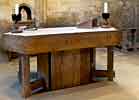 Hexagonal altar Hexagonal altar |
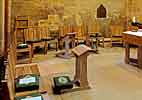 Seats and kneeling desks Seats and kneeling desks |
Designed by Ronald Sims in 1988 and made by Houghton of York.
Stalls
There are 19 individual seats, together with six matching kneeling desks, designed by Ronald Sims in 1988 and made by Houghton of York.
Hexagonal lighting set
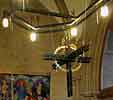 This was designed by Ronald Sims in 1988.
This was designed by Ronald Sims in 1988.
Portrait
The portrait by an unknown artist on the west wall to the north of the entrance has been identified as that of St Catherine, and is thought to have come from the former Chapel of St Catherine, Westhorpe.
Chair
The chair by the door was made in the 19th century in Ottery St Mary, Devon, and was given to the minster by Canon Bailey.
Kneelers
The green kneelers with designs of ivy and oak were made by a group of embroiderers in Grimsby.
Tapestry
![]() The tapestry is by Geraldine Brock and was commissioned by the Nottinghamshire Constabulary in 1990 to commemorate 150 years of policing in the county. St James, the patron saint of pilgrims, is seen with a staff, a purse and a bag decorated with a shell, and is the focal point of the design. The figures on horseback are characters associated with The Canterbury Tales: Chaucer himself, the Man of Law and The Pardoner. Various symbols, some local, are incorporated into the design: the dove of peace, the minster pepperpots, the Chapter House, the scales of justice, Sherwood Forest, ploughed fields and the River Trent.
The tapestry is by Geraldine Brock and was commissioned by the Nottinghamshire Constabulary in 1990 to commemorate 150 years of policing in the county. St James, the patron saint of pilgrims, is seen with a staff, a purse and a bag decorated with a shell, and is the focal point of the design. The figures on horseback are characters associated with The Canterbury Tales: Chaucer himself, the Man of Law and The Pardoner. Various symbols, some local, are incorporated into the design: the dove of peace, the minster pepperpots, the Chapter House, the scales of justice, Sherwood Forest, ploughed fields and the River Trent.
Holy Family sculpture
In the old aumbry stands a delightful sculpture of the Holy Family, depicting Jesus as a young boy with Mary and Joseph: all have European facial features. It was carved by Cecelia Webb (1889-1970) of Melton Mowbray in 1949 and it is known that a Mr Bruce Coleman and his mother and father, residents of that town, were the models for the group. The work was commissioned by Dr Mary Elliott of Cropwell Butler and presented to the minster as a memorial to her parents.
The Friends of Southwell Cathedral contributed to the cost of refurbishing the Pilgrims’ Chapel.
The Historic Chapter Library
Immediately to the west of the chapter house passage is a door, which when entered, leads up some steep and awkward steps to the Historic Chapter Library, housed on the floor above the Pilgrims’ Chapel to the north of the choir. The space has had a number of uses over the centuries and was previously called the Old Treasury.
The present door is seventeenth century and is of painted deal. The two vestry doors nearby were designed by W D Caroe in 1919.
It is established that the Canons of the Collegiate Church had a library before the Civil War although little is known about it. In 1548, in a valuation made for the Chantry Commissioners of Edward VI, ‘certaine books in the librarie’ were recorded and valued. Most of the contents of the Library were lost with the scattering of books and charters in the churchyard by Scottish soldiers in 1645. After the Restoration of the Monarchy in 1660, the Chapter was re-established, and by 1690 a start was made in creating a library. A fine collection of books was given by a certain Edward Lee of Norwell, and many are still identifiable since they have his signature.
The restored collection was housed in the old Grammar School chamber at the west end of the south nave aisle eastwards from Booth’s Chapel. Lee’s collection was augmented from time to time by gifts from the canons and vicars and by a few books bought by the chapter in the eighteenth century. In 1784, Booth’s Chapel and the library were pulled down and the books were then housed in a new room built to the east of the south transept. This building was in turn pulled down in 1825 and the books removed to the music school and vicars’ vestry (now the Airmen’s Chapel) where they remained until well into the twentieth century. Finally the books were put into the old treasury where they are at present.
The historic archives, however, were for many years housed in the parvise room above the north porch, accessed from the north side triforium. In 2003, most of this archival material was deposited at Nottinghamshire Archives in Nottingham, although catalogues are still maintained in the library.
The Historic Chapter Library is bounded on the south side by the north wall of the choir and on the west side by the inner east wall of north transept triforium. In the middle section of the latter there is a small blocked doorway: it is clearly visible from the ground floor of the transept, on the inner side of the walkway. The library has four windows to the east, which look down onto the inner 'courtyard' area bounded by the chapter house, St Thomas’ Chapel, the north wall of the choir and the chapter house passage. On the fourth (northern) side of the library, the windows look towards Church Street.
The choir
Roman ceiling plaster
 Although this plasterwork, painstakingly put together from recovered fragments, is displayed in the vertical, it once graced the ceiling of a bath-house of the Roman villa in Southwell. It was discovered during an archaeological excavation in 1959 off Church Street near the old Minster School buildings. A cupid and fishes can be seen as well as what looks rather like a turtle. The painting is at least 1600 years old.
Although this plasterwork, painstakingly put together from recovered fragments, is displayed in the vertical, it once graced the ceiling of a bath-house of the Roman villa in Southwell. It was discovered during an archaeological excavation in 1959 off Church Street near the old Minster School buildings. A cupid and fishes can be seen as well as what looks rather like a turtle. The painting is at least 1600 years old.
The archaeologists concluded that the original bath-house must have been replaced by a second and probably larger one. During reconstruction, the plaster was scraped off the ceiling and the fragments left to lie on the floor. Then a new floor was concreted in. During the dig the fragments were found, recovered and painstakingly fitted together. There are more fragments, but they do not make a recognizable picture.
Stations of the Cross
 Stations of the cross Stations of the crossin the south choir aisle |
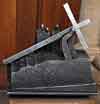 Station 5 Station 5 |
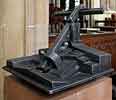 Station 11 Station 11 |
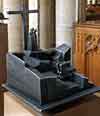 Station 13 Station 13 |
This series of 14 touchable sculptures cast in aluminium by the artist Jonathan Clarke was originally destined for the rear garden of Sacrista Prebend in Westgate. (A companion piece by Clarke – 'The Road to Emmaus' – is at the front of that building). Persistent vandalism of the latter led to the Stations being confined to the minster. They are displayed at different times in three different locations in the Minster: the south choir aisle, the chapter house passage, or the chapter house itself. The square columns upon which the sculptures rest were funded by the Friends of Southwell Cathedral in 1999.
Choir pulpit
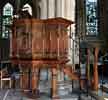 |
 |
 Virgin and Child Virgin and Child |
The choir pulpit is of teak and was designed by W D Caroe and made by Robinson of Bloomsbury. The carving shows the Virgin and Child. The pulpit was the gift of the Ecclesiastical Commissioners and was dedicated by Bishop Ridding on 9 May 1897. The words inscribed upon it read 'In the beginning was the word'.
Until 1987 every preacher climbed into the pulpit using stairs from the Airmens’ Chapel, but in that year the arrangements were remodelled by Ronald Sims: the previous entry was closed with a new panel and a new opening was created on the other side of the pillar, allowing new steps to be built from chancel level.
Model of the minster
This was made by Clive Holmes from Holton-le Cley, a serving fire officer in Cleethorpes who requested anonymity when he presented it to the minster. It contains 35,000 matchsticks and took three years to build.
Ecce Homo ('Behold the Man')
Another wooden sculpture by Peter Ball, made from part of a railway sleeper, with copper for the hands, feet and head. This is often to be found in the north choir aisle, west of the Airmen’s Chapel, but it may be positioned elsewhere.
Mothers’ Union banners
Hanging on the north wall just to the west of the model case is a Mother’s Union banner. It is inscribed Southwell Minster and is the banner of the Minster Branch. Nearby is the diocesan banner, which is on a metal stand. It was made in 2003 to replace a previous fabric which had become worn and carried the legend 'THE DIOCESE OF SOUTHWELL'. In 2006, after the name of the Diocese had been changed, it was necessary to send the banner back to the maker (Juliet Hemingray of Derby) for the wording to be altered to 'THE DIOCESE OF SOUTHWELL AND NOTTINGHAM'.
Royal Coat of Arms
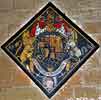 Above the string course just to the west of the library door is a diamond-shaped board. At first sight a hatchment, it is in fact the Coat of Arms of Charles I with the date 1629 upon it. 1629 was the year that Charles I dismissed his third Parliament and embarked upon an eleven year period of Personal Rule: as a consequence, there may have been an order to churches to display the Coat of Arms.
Above the string course just to the west of the library door is a diamond-shaped board. At first sight a hatchment, it is in fact the Coat of Arms of Charles I with the date 1629 upon it. 1629 was the year that Charles I dismissed his third Parliament and embarked upon an eleven year period of Personal Rule: as a consequence, there may have been an order to churches to display the Coat of Arms.
It is surprising that the board survived the Commonwealth period in such a Parliamentary town, but it may have been hidden. The Friends of Southwell Cathedral paid for its conservation in 1995.
Wymondesold charity board
To the west of the Royal Coat of Arms is a rectangular board with the following inscription:
| Thomas WYMONDESOLD of Lambeth in the County of Surrey Esqr gave unto this Church a sett of Chimes and 20s per An: for ever toward the keeping of them 1693 D.C. Res |
Mr Wymondesold’s Chimes were badly damaged by the disastrous fire of 1711, but were repaired.
Royal Maundy
Immediately beneath the Wymondesold board is a montage recording the visit by Queen Elizabeth II in 1984 (the Centenary of the Diocese) to distribute the Royal Maundy.
Large charity board
High on the north wall of the choir is a large board recording Donations to the Poor of the Parish of Southwell. There are two columns and the text reads:
|
||||||||||||||||||||||||||||||||||||||||||||||
Choir lectern
 The eagle lectern in the choir was made in Tournai in 1503 and was the property of the monks of Newstead Abbey. During the Dissolution of the Monasteries (1536-40) the monks wrapped up the lectern and lowered it into the Abbey lake. They were summarily banished and the Abbey and the estate were given to Sir John Byron, so the monks were never able to reclaim the lectern.
The eagle lectern in the choir was made in Tournai in 1503 and was the property of the monks of Newstead Abbey. During the Dissolution of the Monasteries (1536-40) the monks wrapped up the lectern and lowered it into the Abbey lake. They were summarily banished and the Abbey and the estate were given to Sir John Byron, so the monks were never able to reclaim the lectern.
It remained beneath the water for 250 years, at which point the lake was drained and the lectern was discovered. It was sent to Nottingham for cleaning and to be auctioned: eventually it was purchased by the Dean of Lincoln, Sir Richard Kaye, a former Prebendary of the Minster. Sir Richard presented it to the minster on 18 April 1805.
Around the shaft is the inscription:
| Orate ana Radulphi Savage et pro anabus omn fidelium Defunctorum |
Translation: 'Pray for the soul of Ralph Savage, and for the souls of all the Faithful Departed.' (Livett, 1883).
Chandelier
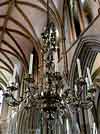 A brass chandelier hangs above the eagle lectern. It carries the inscription 'BONI EX BONIS 1769'.
A brass chandelier hangs above the eagle lectern. It carries the inscription 'BONI EX BONIS 1769'.
For many years the ornamental finial, taking the form of five swirling tongues of flame, had been missing: but through the generosity of the Friends of Southwell Cathedral, a new finial was cast in 2006.
Choir stalls
There are four blocks of stalls on both the north and the south side.
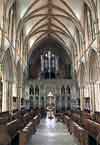 Choir stalls Choir stallslooking west |
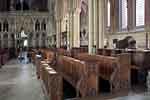 North choir stalls North choir stalls |
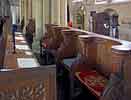 North choir stalls North choir stalls |
 Carving by Simpson Carving by Simpsonon the north choir stalls |
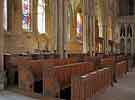 South choir stalls South choir stalls |
Simpson Stalls
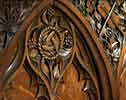 Detail of carving on Detail of carving onnorth choir stalls |
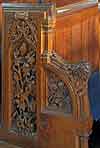 South choir stall South choir stall |
The four blocks of choir stalls (two to the north and two to the south) were carved in 1886 by Charles Henry Simpson (1856-1936), who was the principal woodcarver for the firm of Cornish and Gaymer of North Walsham in Norfolk. They show a multitude of wonderful carvings of plants, animals, insects, musical instruments and mythical creatures. There are also two Green Men, one looking very much like a cat.
The cartoons of C H Simpson’s carvings were presented to the minster in 1934 and are in the chapter library. From time to time they are on display in the three glass display cases in the chapter house passage.
Caroe Stalls
The blocks of stalls to the east of the Simpson pews were designed by W D Caroe and were dedicated on 5 February 1902. They were also made by Cornish and Gaymer, but whether the carver was C H Simpson is not known.
A brass plaque is affixed to the Sacrista stall in the south choir stalls. The inscription reads:
THIS STALL WAS HELD |
Honorary canons' stalls
The back rows of stalls on both the north and south sides, and extending across both the Simpson Stalls and the Caroe Stalls are named for the honorary canons. (New canons are 'placed in their stall' at a service in the minster). All such stalls carry the names of the parishes, not names of individuals.
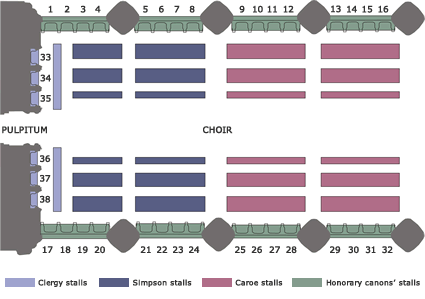 |
|
(Prebendal stalls shown in capitals. Nameplates reproduced exactly as styled).
Clergy stalls
The six clergy stalls are built into recesses in the east wall of the pulpitum. Each stall has a misericord, carved from oak and dating from the 14th century. The stall to the south of the centre aisle is the Bishop’s Stall, whilst the one to the north of the aisle is the Dean’s Stall. The decoration on the back of the Bishop's stall is called diaper work and the stall itself is usually known as Wolsey’s Stall: it was used by him when he lived for five months in the Archbishop’s Palace in 1530 and preached in the minster.
Details of misericords in the six stalls, named for their offices, from north to south:

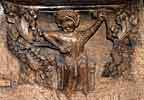 Archdeacon of Newark (Stall 33 on the plan above)
Archdeacon of Newark (Stall 33 on the plan above)
Seated figure with a bough springing from side.
Plaque on the stall reads 'ARCHDEACON'.
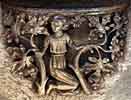 |
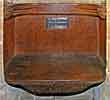 |
Assistant (Suffragan) Bishop (Stall 34 on the plan above)
Kneeling figure holding foliage.
Plaque on the stall reads 'EPISCOPUS DE SHERWOOD'.

 Dean (Stall 35 on the plan above)
Dean (Stall 35 on the plan above)
Owl or beetle-like body with hooded cloak, a human head and tail turning into a branch.
Plaque on the stall reads 'DECANUS'.

 Bishop (Stall 36 on the plan above)
Bishop (Stall 36 on the plan above)
Two dryads with tails turning into foliage.
Plaque on the stall reads 'EPISCOPUS'.

 Bishop of Sherwood (Stall 37 on the plan above)
Bishop of Sherwood (Stall 37 on the plan above)
Green Man with two boughs from mouth.
Plaque on the stall reads 'THE CHANCELLOR OF THE DIOCESE'.

 Archdeacon of Nottingham (Stall 38 on the plan above)
Archdeacon of Nottingham (Stall 38 on the plan above)
Samson breaking the jaw of a lion.
Plaque reads 'ARCHDEACON'.
Wooden screens
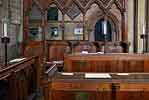 Screen between north Screen between northstalls and north aisle |
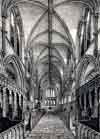 Choir stalls and Choir stalls and plaster screens (1839) |
There are oak screens between the stalls and the choir aisles on both the north and south sides. These are in the two most westerly bays. They were erected between 1875 and 1887 by Cornish and Gaymer, to replace the plaster screens built by the Bernasconi brothers (which had canopies over the back row of stalls).
Music stand
The music stand, positioned on the north side at the eastern end of the more westerly of the Simpson stalls, is of oak and was made by Robert Lee of Southwell in 1947.
St Thomas’s Chapel
This was possibly the site of the first chantry chapel, founded in 1241 by Robert de Lexington and dedicated in honour of St Thomas the Martyr (Thomas Beckett).
 Sedilia Sedilia |
The south wall of the chapel has a set of five-seat sedilia. There is an aumbry in the north wall and a double piscina in the east wall.
At the present time this chapel is being used as a clergy vestry, with a curtain closing it off. For the moment, therefore, visitors do not have access to it. From outside, however, it is possible to see, above the curtain, something of the three very fine two-light windows by Kempe which the Chapel contains.
The fittings within the chapel include more work by Robert Thompson.
Altar
 The altar is by Thompson and is half of the original nave altar.
The altar is by Thompson and is half of the original nave altar.
Cross and candlesticks
These are by Thompson.
Prayer desk
This is a Thompson piece.
Credence table
Given in 1926 in honour of Mrs E A Merrywether.
Airmen’s Chapel
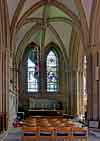 The Airmen's Chapel The Airmen's Chapellooking east |
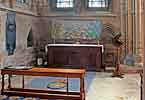 The east end of the The east end of theAirmen's Chapel |
This chapel was, some believe, the site of the chantry chapel founded by Richard Sutton in 1283 and dedicated in honour of St Peter and St Paul. It is also, perhaps, the site of the tomb of Archbishop de Corbridge.
It became the Airmen’s Chapel in March 1984, the title being transferred from the chapel now called The Pilgrim’s Chapel.
There is an aumbry space in the north wall and a double piscina set into the east wall.
The fittings within the Chapel are listed below.
Altar
The altar in this chapel is made from pieces of wood taken from crashed aircraft during the First World War, and was made by apprentices at an RAF station near Sheffield. It was formerly used in the church at Norton Woodseats and given to the minster in 1919. The cross is made from used shell cases.
Triptych
 The triptych (a painting on three hinged panels, which can be in either the open or the closed position) was created in 1988 by Hamish Moyle, a member of the Little Gidding Community, and was inspired by Dame Edith Sitwell’s poem And Still Falls the Rain, a work which speaks of sacrifice and the tragedy of war.
The triptych (a painting on three hinged panels, which can be in either the open or the closed position) was created in 1988 by Hamish Moyle, a member of the Little Gidding Community, and was inspired by Dame Edith Sitwell’s poem And Still Falls the Rain, a work which speaks of sacrifice and the tragedy of war.
On the communion rail is a miniature of the triptych, enabling both positions to be examined. On the back of the replica is the text of the poem.
Carved lectern
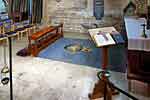 Communion rail, carpet Communion rail, carpet with RAF crest and lectern |
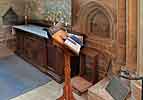 Aumbry, altar, lectern Aumbry, altar, lecternand double piscina |
The provenance of this lectern, with its very fine carved wooden eagle, has not been determined.
Communion Rail
This was made at RAF Newton in 1984. The top is of teak and carries a carving of an albatross.
Kneelers
The embroidered kneelers were designed by Professor Anne Morrell and embroidered by local ladies.
Carpet
The blue carpet with the RAF crest was given by the variety artistes Elsie and Doris Waters ('Gert and Daisy') in 1941 'in thanksgiving for the devotion and bravery of the RAF in the present conflict'.
Small kneeling desk
This is of oak and was made at RAF Cranwell in 1926.
Chair
In the south-west corner of the chapel is a chair which has a small plate on the back carrying the inscription:
| In loving memory of MURRAY JOHN TOWNLEY 1926-1997 'They shall mount up with wings as eagles' |
Chairs
Sixteen chairs are set out 4x4, but the configuration can be changed.
Sanctuary
Much of the oak furniture was made in the workshops of Robert Thompson of Kilburn in North Yorkshire in 1949. His pieces always carry a small carved mouse.
Altar cross
 The inscription along the base of the silver altar cross reads:
The inscription along the base of the silver altar cross reads:
In thanksgiving to God |
Communion rail
 The Communion Rail is a fine pierced work by Thompson, featuring the characteristic rippled top produced by the use of the adze, an ancient hand tool. There is a mouse low down to the north and to the south.
The Communion Rail is a fine pierced work by Thompson, featuring the characteristic rippled top produced by the use of the adze, an ancient hand tool. There is a mouse low down to the north and to the south.
Three-person kneeling desk on south side
An outstanding piece of Thompson work, delivered to the Minster in 1949.
Small kneeling desk in lighter oak on south side
By Robert Thompson, but believed to be of later date than 1949.
Cathedra
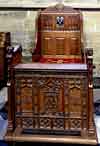 Cathedra and desk Cathedra and desk |
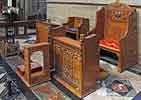 Cathedra, desk and Cathedra, desk and Dean's Chair and Desk |
The Cathedra is on the North side. It is by Robert Thompson and was made as a memorial to Bishop Mosley. The inscription reads:
IN GRATEFUL MEMORY OF |
There is a carved mouse on the left (east-side) arm support.
The desk was given by the parish as a memorial to Bishop Hoskyns in 1926. A brass plate on the desk reads:
IN MEMORY OF EDWYN HOSKINS, BISHOP |
Along the bottom of the desk side is another inscription:
EDWYN HOSKYNS BISHOP |
Dean’s chair and kneeling desk
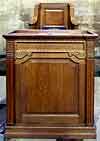 Made of oak by Robert Thompson in 1957. It is a memorial to Provost W J Conybeare who was rector from 1919 to 1945 and bears his coat of arms. The inscription reads:
Made of oak by Robert Thompson in 1957. It is a memorial to Provost W J Conybeare who was rector from 1919 to 1945 and bears his coat of arms. The inscription reads:
IN MEMORY OF WILLIAM JAMES CONYBEARE 1871 - 1955 |
Small kneeling desk on north side
By Robert Thompson, but believed to be of later date than 1949
Chairs and credence table
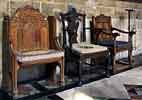 There are five chairs of various provenance and a small credence table.
There are five chairs of various provenance and a small credence table.
The small paneled credence table had been an altar in a village church near Devizes. It was found in a farmhouse, covered in paint and in use as a cupboard. It was bought, cleaned and given to the Minster.
The provenance of the chairs placed either side of the Credence Table is not known.
Sanctuary Floor
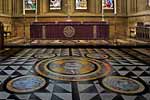 The marble floor in the Sanctuary was laid in 1887.
The marble floor in the Sanctuary was laid in 1887.
Sedilia and piscina
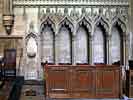 Piscina and sedilia Piscina and sedilia |
 Detail of the Detail of the decorated canopy |
 Detail of the Detail of the decorated canopy |
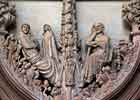 Detail of carving Detail of carving |
The stone seats with a decorated canopy on the south side of the sanctuary date from about 1340. Three seats are the normal complement, but here there are five: a very rare provision. The sedilia have not always been in this position, as evidenced by the fact that they obscure the lower part of the window. The piece underwent some restoration work in the nineteenth century, carried out by the brothers Bernasconi.
St Oswald’s Chapel
This chapel is dedicated to St Oswald, Archbishop of York from 962 to 992, who had an important role in establishing the Saxon minster. The fittings within the chapel include are listed below.
Altar
 St Oswald's Chapel St Oswald's Chapel |
 Altar with raven frontal Altar with raven frontal |
The altar frontal featuring a raven is by John Piper (an alternative bright green frontal, given to the Minster by the Diocese of Natal, may be in use). Piper also did the gilding and other refurbishment. The artist’s research told him that St Oswald had a raven as a personal device: unfortunately he looked up the wrong St Oswald. The real dedicatee was Archbishop of York and represents a further strong York connection for the minster. He died in Worcester in 992, washing the feet of the faithful on Maundy Thursday – he was Bishop of Worcester as well as Archbishop.
The other St Oswald lived from 605 to 642. After the pagans had killed King Edwin in 633 and Christianity had been sent into retreat, Oswald fought back, seized the throne of Northumbria and revived Christianity throughout the north. Stories about him relate that his constant companion was a pet raven. He revitalized York as a Christian centre, so the 'wrong' Oswald does have a link with Southwell after all!
Reredos
 The reredos The reredos |
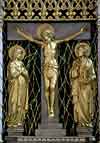 Detail Detail |
The limed oak reredos was designed by W D Caroe and carved by Messrs Boulton of Cheltenham. The figures were gilded in 1990 at the expense of Mr Eric Freckingham under the supervision of Ronald Sims.
Credence table
The credence table is by Robert Thompson, with an incised mouse.
Altar rails
The two altar rails were made in memory of John Huxley, Canon of Norwich, who was at the minster from 1883 to 1900. A brass plate on one of the altar rails reads:
IN |
The red kneelers were embroidered in 1982 by a group led by Mrs Wakeling, the wife of the 7th Bishop of Southwell.
Sedilia
 A set of three-seat stone sedilia is on the south wall of the chapel.
A set of three-seat stone sedilia is on the south wall of the chapel.
The Chapel of Christ the Light of the World
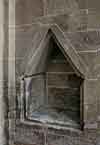 Aumbry Aumbry |
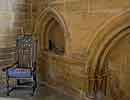 Double piscina Double piscinaand tomb recess |
This former chantry chapel has been known variously as the Blessed Walter Hilton Chapel, the Southwell Saints Chapel and the Boys Chapel. It is now designated as a secluded place reserved for private prayer and contemplation. Individuals may come and kneel in prayer, or light a candle to a loved one, or complete a petition card.
There is an aumbry in the east wall and a double piscina in the south wall, which also has a tomb niche.
The fittings within the chapel include are listed below.
Christ the Light of the World
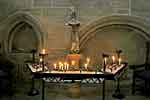 Another sculpture carved by Peter Ball and completed in 1990.
Another sculpture carved by Peter Ball and completed in 1990.
The Friends of Southwell Cathedral contributed to the cost.
Votive candle stand
The candle stand was designed by Martin Stancliffe, made by Don Barker and Houghton’s of York and given by the Friends of Southwell Cathedral in 1992.
Sedilia
 The sedilia The sedilia |
There is a set of three-seat stone sedilia on the west side of the chapel.
Pair of chairs
The eighteenth century chairs in the south-west corner and in the south-east corner are for the use of the Lord Lieutenant and the Lord Lieutenant’s Lady. They are of oak, carved and pegged in the gothic style. The cushions for these two chairs were made for them when they stood in the Airmen’s Chapel and the cushions match the kneelers in the latter location
Pair of chairs
Two plain chairs for the Archdeacons, one along the east wall, to the south and the other along the east wall, in the middle.
Chair
A chair along the east wall, to the north, with a mitre, commonly referred to as the Bishop of Sherwood’s chair, but older than that office.
Kneeling bench
Provenance not known.
Table
The table in front of the small door is used for prayer cards.
Wooden lectern
This is by Robert Thompson of Kilburn.
The chapter house
The chapter house is accessed from the north choir aisle by descending three steps and walking along the passageway. It is presumed that the chapter house was built externally and then the passageway was built to link it to the church. The entrance arch projects above the string course. The foliage on the arch and the capitals is: to the left, hawthorn and buttercup; to the right, maple with winged seeds.
The wrought iron gates were installed in 1934 and were made by Frederick Cauldron, a blacksmith from Brant Broughton. The Bishop's arms are on the left, with Provost Conybeare's on the right. (In the same year Mr Cauldron made wrought iron gates which were installed at the entrances to the north and south choir aisles).
The buttresses of the Pilgrims' Chapel are built into the south wall. The present roof was put in by Ewan Christian in the 19th century, together with the small doorway, and the larger one giving on to a spiral staircase to the roof space.
Chapter house stalls
 Stalls Stalls |
 Stalls Stalls |
Each member of the chapter had his own stall in the chapter house as well as in the choir. His title and his income came from the village he represented, hence the names on the stalls.
The old minster chapter ceased to be in the late nineteenth century, but the present cathedral has a chapter which continues with the traditional names.
The stalls are named as follows from the presidential seat (inscribed Decanus):
| Clockwise: | Counter-clockwise: | |
| Not named | Episcopus de Sherwood | |
| Archdiaconus de Newarch | Archdiaconus de Nottingham | |
| North Muskham | Sacrista | |
| Kelham | South Muskham | |
| Lenton | Beckingham | |
| Dunham | Wellbeck | |
| Beauvale | Rufford | |
| Thurgaton | Halloughton | |
| Normanton | Mattersey | |
| Norwell Overhall | Norwell Palishall | |
| Woodborough | Oxton Prima Pars | |
| Retford | North Leverton | |
| Norwell Tertia Pars | Eaton | |
| Rampton | Oxton Secundus | |
| Not named | Not named | |
| Not named | Not named | |
| Not named | Not named |
The 36th seat on the north side of the entrance arch is not named.
Table
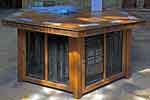 The hexagonal table was originally a tester (a sounding board above a pulpit) and was given by Gedling All Hallows, when it became redundant there. It is inscribed with the following (each phrase occupying one of the six sides):
The hexagonal table was originally a tester (a sounding board above a pulpit) and was given by Gedling All Hallows, when it became redundant there. It is inscribed with the following (each phrase occupying one of the six sides):
If thou chance to find
An house build to thy mind
Without thy cost
Serve thou the more
God and the poor:
And then thy labour’s not lost
Chair
The chair, commonly called Cromwell’s Chair is probably 17th century, but little is known about it.
Small table
This is a Jacobean walnut table used by the Chapter. Probably one of the best pieces of furniture in the Minster.
Passage table
Outside the chapter house entrance arch, at the north end of the passageway is a copy of the Gedling table, but of much later date.






